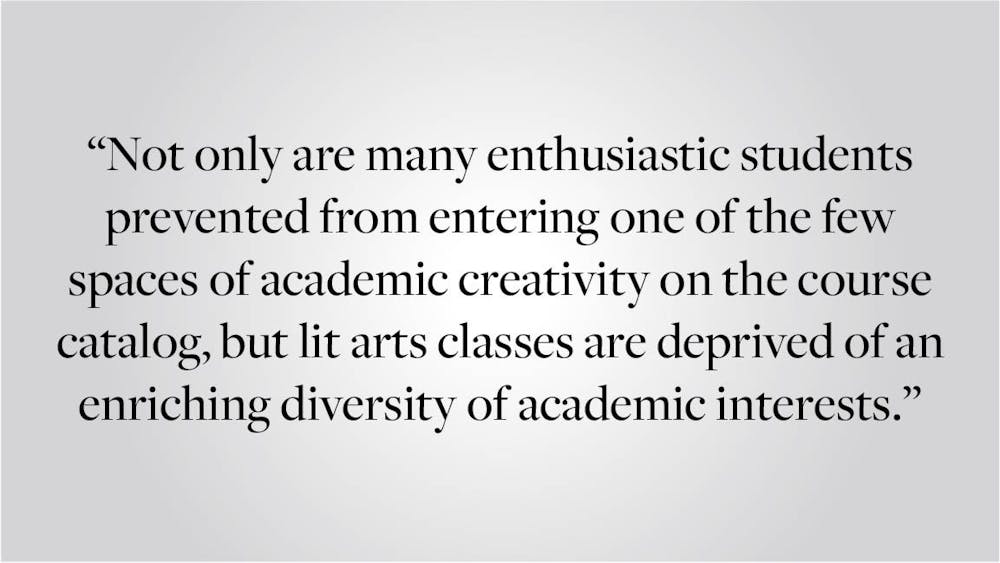For a small slice of Brown’s campus, the first Monday of each semester is marked with a big red dot on the calendar. Those of us who observe this hallowed day spend it in a nervous thrall, compulsively refreshing our web pages in anticipation of the news that will break hearts and bring tears: the literary arts class lists. The candidates are many and the spots are few — some courses, like this semester’s LITR 1110U: “Script to Screen: Fundamentals of Filmmaking” only have eight seats. The writing sample submitted five days prior is all that can vouch for our ability; our chances are otherwise left up to the lottery gods.
For the fall 2021 semester, every literary arts class — except workshops at the 100 and 110 level and LITR 1200: “Writers on Writing,” which use a lottery system — required a writing sample. Brown takes pride in its idiosyncratic Open Curriculum as an empowering force that gives students “greater freedom to study what they choose and the flexibility to discover what they love.” But all too often, non-lit arts concentrators interested in exploring creative literary studies find themselves boxed out of these classes due to competitive admissions. Writing samples are used so frequently and so automatically by the literary arts department that it has gained a reputation for exclusivity that ultimately functions to its detriment. Hobbyists who find joy in creative writing are left by the wayside and novices are often completely sidelined except for lax introductory classes for first-years. Not only are many enthusiastic students prevented from entering one of the few spaces of academic creativity on the course catalog, but lit arts classes are then deprived of an enriching diversity of academic interests.
As it stands, the highly competitive lotteries for workshops at the 100 and 110 level are the only gateway for beginners to enter the department. Higher level genre workshops and a number of fascinating themed workshops — LITR 1151Q: “Great Adventure” or LITR 1152B: “Ekphrasis in Action,” for example — are largely intended for advanced students, selected via writing sample. Writing samples are an understandable barrier to entry, and advanced classes should absolutely retain them as a requirement; professors want to teach students with compatible styles, proficiency in literary rhetoric and experience in workshop practices. But for beginner courses, these characteristics are somewhat irrelevant. In an introductory context, whether the writer or the writing is actually good is secondary; the primary goal is the cultivation of a structured space in which students can challenge themselves and more deeply understand writing as a process. But for many, this valuable experience is out of reach.
Creativity can be fun, but that far from diminishes its universal applicability and personal value. The process of writing teaches skills valuable for STEM and humanities students alike: clarity of self-expression, the discipline to see a project through many drafts and evolutions, the ability to give meaningful criticism and take it in turn, a rigorous understanding of the minutiae of form and deliberate creative decision-making. And when we turn our attention to modes of self-expression, we have better access to ourselves. It takes bravery and sincerity to offer something original and personal for critique in a room full of one’s peers and a published professor. The practice of creativity demands risk, a type of risk not often encountered in other facets of our academic lives, and one that forces us to grow.
The current exclusivity of the literary arts department limits the variety of perspectives heard in class, a major shortcoming for what is inherently a communal practice. Interdisciplinary thinking is already a value of the department; many lit arts courses, like LITR 0110H: “Digital & Cross-Disciplinary Language Arts 1” and LITR 0310T: “Metaforaging,” are reflective of this. And anyone who has walked under Faunce Arch can testify from Brown’s signage that its supposed breadth of interdepartmental collaboration is advertised as an institutional strength. But, as is, the overwhelming use of writing samples filters out students without an established background in creative writing. Expanding access to lit arts classes stands to reinforce the values that Brown broadcasts publicly.
Enlarging class sizes to accommodate more students is not a viable solution; small classes are imperative to fostering an environment where everyone has the time and confidence to contribute. Instead, course offerings specifically for inexperienced students should be expanded, especially themed workshops, and added courses should employ the same registration process as a small seminar in any other department. Demand among the student body is there — primarily, I think, because creative writing is fun, and fun is not trivial. Sustaining the scope and intensity of our academic lives necessitates that we occasionally find it enjoyable. Greater accessibility to the literary arts department would actually make good on the promise of the Open Curriculum as a haven for the self-motivated, curious mind. Because anyone who brings enthusiasm, openness and curiosity can learn to write. And if they want to, they should be able to.
Isabella Levine ’23 can be reached at isabella_levine@brown.edu. Please send responses to this opinion to letters@browndailyherald.com and other op-eds to opinions@browndailyherald.com.





